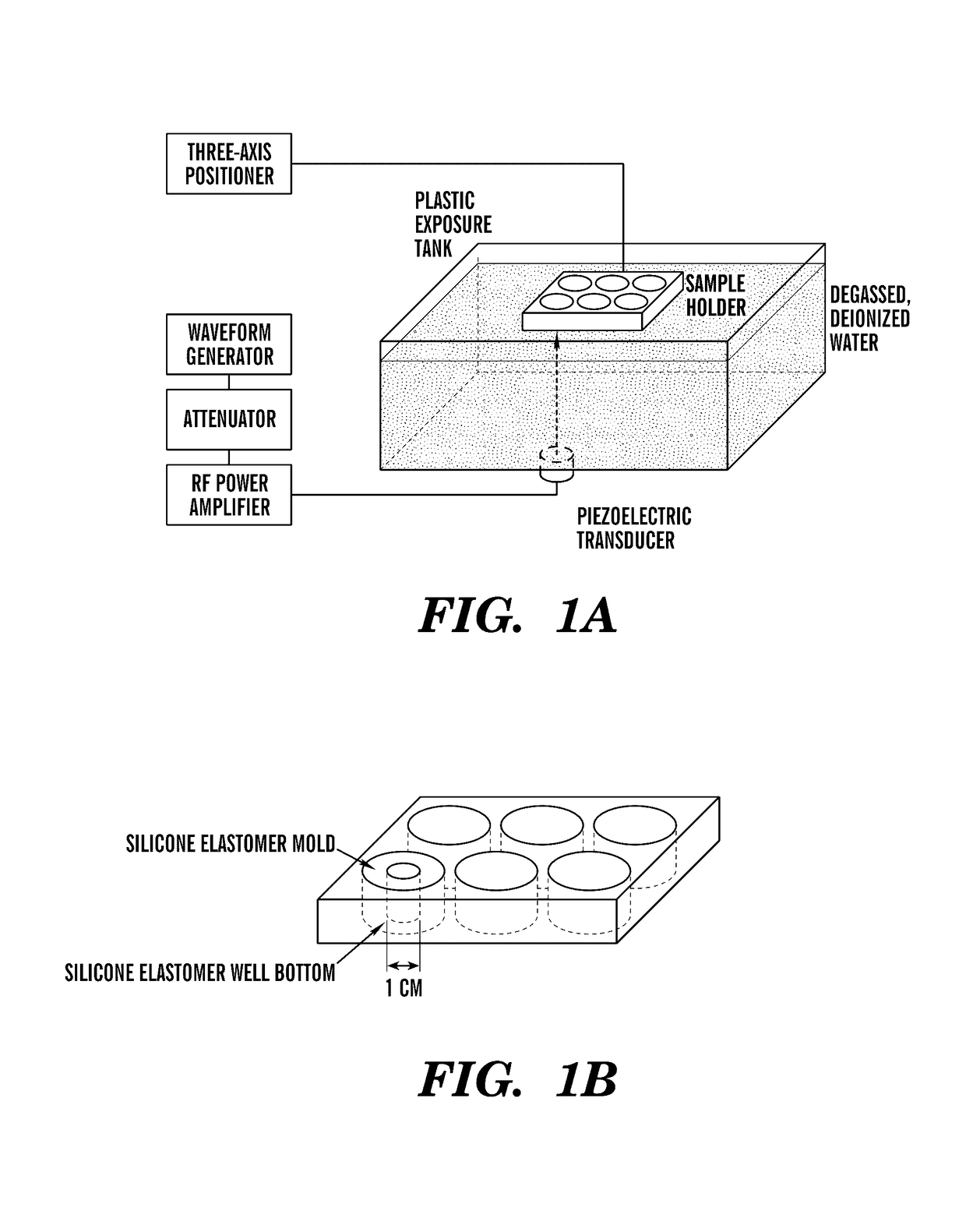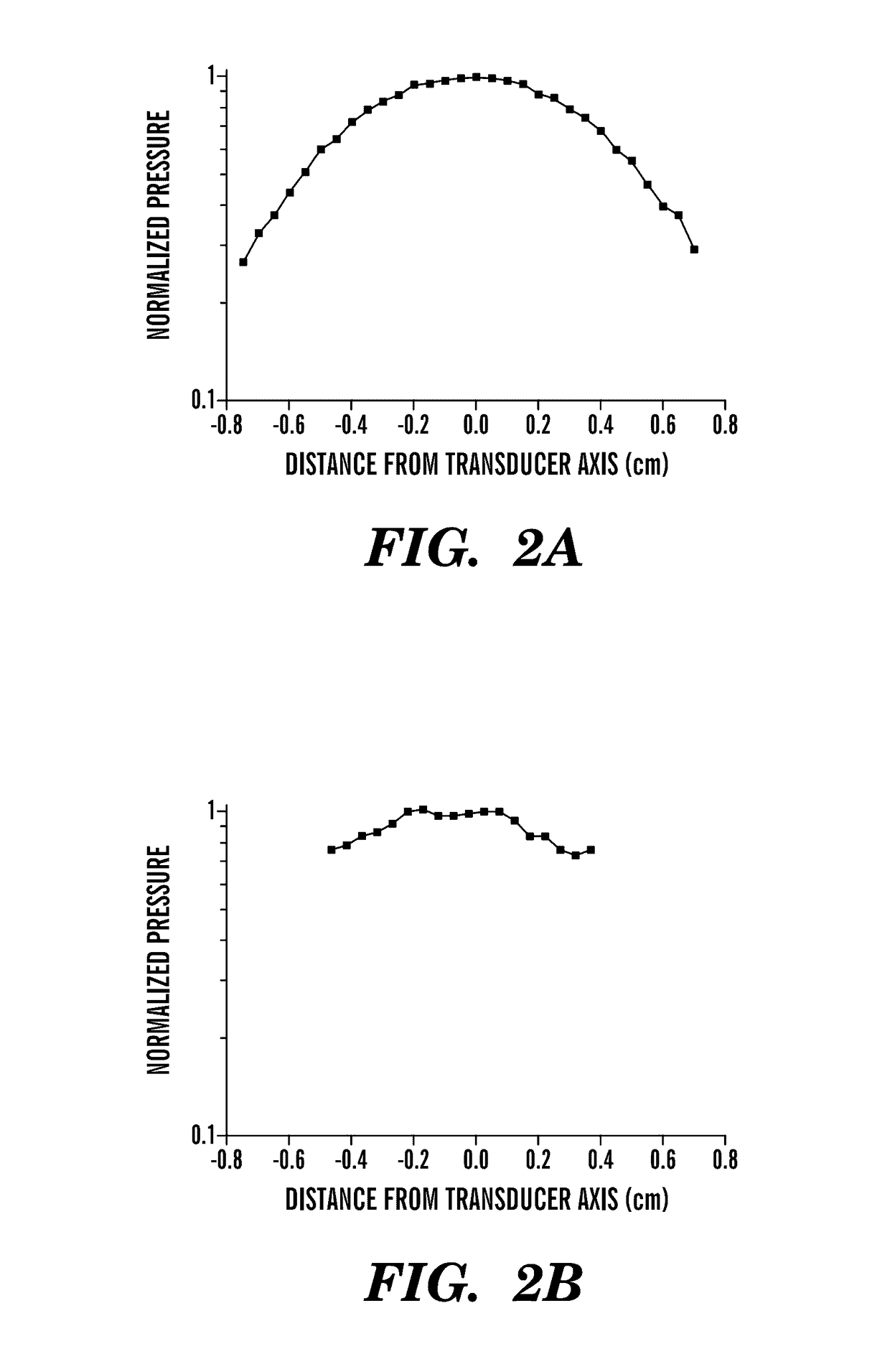Ultrasound technology to control the spatial organization of cells and proteins in engineered tissues
a technology of engineered tissues and ultrasound, applied in the field of ultrasound technology to control the spatial organization of cells and proteins in engineered tissues, can solve problems such as the development of an ultrasound standing wave field (uswf)
- Summary
- Abstract
- Description
- Claims
- Application Information
AI Technical Summary
Benefits of technology
Problems solved by technology
Method used
Image
Examples
example 1
Experimental Set-Up for Ultrasound Exposures
[0088]To investigate the effects of ultrasonic mechanical forces on the promotion of angiogenesis, an ultrasound (US) exposure system was developed in which cells and 3D tissue constructs are subjected to an ultrasound traveling wave field (UTWF) or an ultrasound standing wave field (USWF) (FIG. 1A). Samples are contained within the wells of a modified silicone elastomer-bottomed cell culture plate (FIG. 1B). UTWF are created by minimizing reflections at the sample / air interface with a rubber absorber. USWF are produced by removing the rubber absorber such that the air interface promotes the interference of incident and reflected waves (Blackstock D T, FUNDAMENTALS OF PHYSICAL ACOUSTICS, (Wiley & Sons, 2000), which is hereby incorporated by reference in its entirety). No significant differences in UTWF or USWF are found in the presence of the sample holder compared to without the holder, indicating that the experimental set-up will not int...
example 2
Characterization of Ultrasound Fields
[0091]USWF and traveling wave fields were measured in a water tank and within the sample space using the set-up described above. Resulting spatial distributions of pressure are illustrated below in FIGS. 2A-2D. An unfocused, 1 MHz, 1 inch diameter, piezoelectric transducer was used to produce the US field and a needle hydrophone was used to measure the acoustic pressure.
[0092]For traveling wave fields, transaxial spatial distributions in pressure were measured in the far field, 12.2 cm from the transducer. In the absence of the sample holder, −3 dB and −6 dB beam widths were 0.8 cm and 1.2 cm, respectively (FIG. 2A). The beam pattern within the sample space was not significantly altered from the free field pattern indicating that the sample holder does not interfere with sound propagation (FIG. 2B). The −3 dB beam width remained 0.8 cm, but the −6 dB beam width could not be calculated, indicating that samples will be exposed to a relatively unifo...
example 3
USWF Control of the Spatial Arrangement of Cells Within a 3D Tissue Construct
[0094]The organization of endothelial cells into multicellular assemblies affects angiogenic endothelial cell behaviors (Korff et al., “Integration of Endothelial Cells in Multicellular Spheroids Prevents Apoptosis and Induces Differentiation,”The Journal of Cell Biology 143(5):1341-1352 (1998) and Ino et al., “Application of Magnetic Force-Based Cell Patterning for Controlling Cell-Cell Interactions in Angiogenesis,”Biotechnology and Bioengineering 102(3):882-890 (2009), which are hereby incorporated by reference in their entirety). Exposure of cell suspensions to USWF can result in cellular aggregation at areas of minimum acoustic pressure (the pressure nodes) (Dyson et al., “The Production of Blood Cell Stasis and Endothelial Damage in the Blood Vessels of Chick Embryos Treated with Ultrasound in a Stationary Wave Field,”Ultrasound in Medicine and Biology 1:133-148 (1974), which is hereby incorporated by...
PUM
| Property | Measurement | Unit |
|---|---|---|
| frequency | aaaaa | aaaaa |
| acoustic frequency | aaaaa | aaaaa |
| acoustic pressure amplitude | aaaaa | aaaaa |
Abstract
Description
Claims
Application Information
 Login to View More
Login to View More - R&D
- Intellectual Property
- Life Sciences
- Materials
- Tech Scout
- Unparalleled Data Quality
- Higher Quality Content
- 60% Fewer Hallucinations
Browse by: Latest US Patents, China's latest patents, Technical Efficacy Thesaurus, Application Domain, Technology Topic, Popular Technical Reports.
© 2025 PatSnap. All rights reserved.Legal|Privacy policy|Modern Slavery Act Transparency Statement|Sitemap|About US| Contact US: help@patsnap.com



